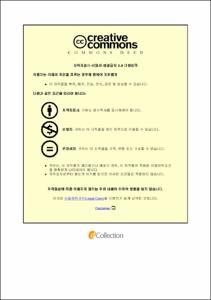Fabrication and Investigation of CuSe Thin Films and Nanofibers
- Alternative Title
- CuSe 박막과 나노파이버의 합성 및 분석
- Abstract
- Copper selenide (CuSe) is composed of earth-abundant and low-toxic elements. CuSe is a type of transition metal chalcogenides (TMCs) compound and has recently been in the spotlight in coating fields such as solar energy collection, optical filters, optoelectronic devices, and electrical devices.
Chapter 2 of this thesis contains the contents on the fabrication of several thin films (TFs) with various proportions of Cu and Se through radio frequency (RF) magnetron co-sputtering. The investigation of chemical and physical properties of CuSe TFs is also demonstrated. The thickness of the TFs was controlled to be about 200 nm to study the change in characteristics according to the compositional ratio of the surface. For Se-rich TFs, it was observed by X-ray photoelectron spectroscopy (XPS) that the lower oxidation number of Cu and the higher oxidation number of Se. In other words, the combination of Cu and Se is dominant in the Cu-rich environment. As a result of X-ray diffraction (XRD), crystals corresponding to CuSe compounds appeared in TFs with high percentage of Cu. Through ultra-violet photoelectron spectroscopy (UPS), it was observed that as the percentage of Se increased, the work function increased from 5.3 to 6.1 eV.
In Chapter 3, we fabricated CuSe TFs using RF magnetron co-sputtering under different conditions from the samples produced in Chapter 2. As a result of XRD, amorphous phase appeared in all TFs. Various crystalline CuSe phases were observed as amorphous TFs were annealed at 423, 573, and 873 K. The temperatures were chosen by considering the melting point and boiling point of Se. Morphology changes between the pristine TFs and annealed TFs were investigated with scanning electron microscopy (SEM) and atomic force microscopy (AFM). In the case of unannealed TFs, as the percentage of Se increased, the surface became smoother and the roughness decreased. However, in the annealed TFs, morphology and roughness changed severely in TFs, where the percentages of Se were high. Surface free energies (SFEs) were calculated from the contact angles obtained by dropping two solvents on the surface of TFs. The dispersive SFE could be increased by Se.
Finally, in Chapter 4, CuSe nanofibers (NFs) with various calcination temperatures and mole percentages of Cu to Se were synthesized by electrospinning. The diameters of each NFs were calculated with the images of SEM. The diameters of uncalcined CuSe NFs decreased according to the interatomic distance as the mole percentage of Se increased. On the other hand, the diameters of calcined NFs increased due to aggregation. Generally, Se-rich NFs aggregated well and maintained the fibrous shape even if they were calcined at high temperatures. Through XRD, the peaks corresponding to cubic Cu2Se phase appeared in NFs calcined at 873 K. The highest intensity of Cu2Se peaks was observed in CS40-873. As the results of XPS and EDS, Cu was covered by Se as the mole percentage of Se increased.
- Issued Date
- 2022
- Awarded Date
- 2022. 2
- Type
- Dissertation
- Publisher
- 부경대학교
- Affiliation
- 부경대학교 대학원
- Department
- 대학원 화학과
- Advisor
- 강용철
- Table Of Contents
- CHAPTER I. Theories 1
1.1. Radio frequency magnetron co-sputtering 1
1.2 Electrospinning 6
1.3. Electron emission spectroscopy 9
1.3.1. X-ray photoelectron spectroscopy (XPS) 9
1.3.2. Ultra-violet photoelectron spectroscopy (UPS) 20
CHAPTER II. Investigation of the compositional effect on the physicochemical properties of the CuSe thin films 23
2.1. Introduction 23
2.2. Experimental details 25
2.3. Results and Discussion 32
2.4. Conclusion 60
CHAPTER III. Investigation of the temperature effect on the surface characteristics of the CuSe thin films with various compositional ratio 61
3.1. Introduction 61
3.2. Experimental details 63
3.3. Results and Discussion 70
3.4. Conclusion 100
CHAPTER IV. Investigation of the temperature effect on the CuSe nanofibers with various compositional ratio 101
4.1. Introduction 101
4.2. Experimental details 103
4.3. Results and Discussion 107
4.4. Conclusion 135
REFERENCES 136
APPENDICES 151
KOREAN ABSTRACT 175
- Degree
- Master
- Files in This Item:
-
-
Download
 Fabrication and Investigation of CuSe Thin Films and Nanofibers.pdf
기타 데이터 / 12.25 MB / Adobe PDF
Fabrication and Investigation of CuSe Thin Films and Nanofibers.pdf
기타 데이터 / 12.25 MB / Adobe PDF
-
Items in Repository are protected by copyright, with all rights reserved, unless otherwise indicated.